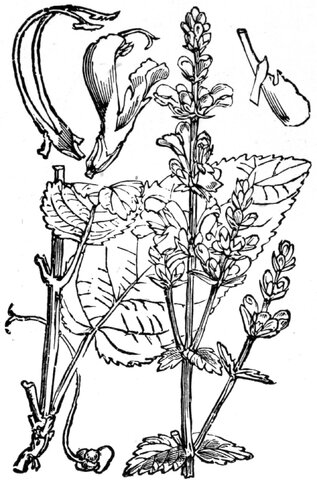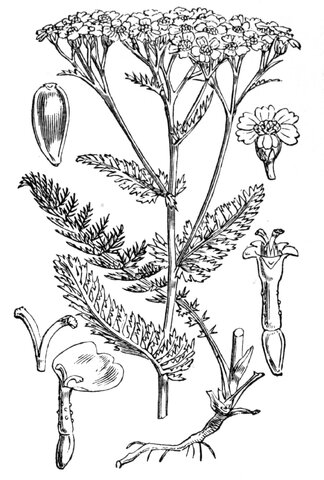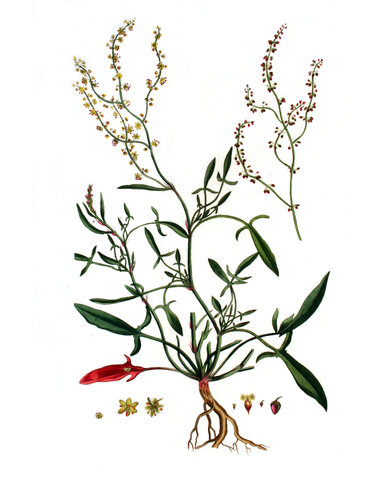Archive of Poales, Doyenne of Healing.
“The dose makes the poison,” Poales teaches her daughter Mibora. As Doyenne of Healing, she is responsible for the physical well-being of the Grass People. She knows all the herbs on the Great Plain and their effects.
-

Goutweed (Aegopodium podagraria)
“This is goutweed, especially common in and around deciduous forests. Grows like a weed. Whole colonies can sprout from one rootstock. You can recognize it by its triangular stem and double trifoliate or bipinnate leaves. You must not confuse goutweed with spotted hemlock. It is highly poisonous! That’s why it’s so important to remember the leaf shape and triangular stem. Also, hemlock has an intense smell that you won’t forget.” Poales points out these features to Mibora.
Goutweed has been used for centuries in folk medicine to relieve the pain of rheumatism and gout (podagra). It is also said to be effective against rheumatism and arthritis, antispasmodic, detoxifying and blood purifying. In addition, it is a tasty wild vegetable. Raw goutweed reminds of parsley mixed with mango, cooked of spinach.purifying. In addition, it is a tasty wild vegetable. Raw goutweed reminds of parsley mixed with mango, cooked of spinach.
-

Meadow Sage (Salvia pratensis)
“Meadow sage is about the size of yarrow, slightly smaller than goutweed. The flowers are bright blue, the stems are square with basal leaves. The flowering period ranges from the fifth to the eighth moon. The plant can live for several years and is especially fond of bumblebees, which appreciate its nectar. It loves sun and warmth and is found sporadically in our latitudes, in meadows and roadsides.”
This is how Poales, Doyenne of Healing, explains to her daughter Mibora how to find meadow sage and how to recognize it. The plant is believed to have a variety of healing properties in the Grassland: it is hemostatic, antiperspirant, anti-inflammatory, diuretic, antispasmodic and stimulant. Tea made from meadow sage is also popular for treating colds. In addition, sage strengthens the function of the lungs. Finally, it is used in the questioning of the Oracle.
-

Couch Grass (Elymus repens)
“Couch grass is an important healing herb and sacred to us. Used properly, it purifies the kidneys and protects against infection. Starting today, you should always carry some couch grass on your body so its strength and pliability passes into you.”
With these words, Poales succinctly summarizes for her daughter the immense importance of couch grass to the Grass People in general and to the Sisterhood of Green Shadows in particular. She has Mibora cut couch grass shoots and weaves a belt for her from them, as all Shadows wear.
-

Yarrow (Achillea millefolium)
Yarrow has been used as a medicinal plant for thousands of years. Stems, leaves and flowers are used to prepare infusions that have antibacterial, astringent, antispasmodic and bile flow stimulating effects. External antibacterial application is used for inflammations and wounds. Internally, yarrow is used for loss of appetite and digestive problems, as well as bladder, kidney and menstrual disorders.
Yarrows are perennial, herbaceous plants that reach a growth height of seven to 100 centimeters. The thin and horizontal rootstock forms underground or above-ground runners up to 50 centimeters long. The short flowering period ranges from the fifth to the sixth moon.
-

Sorrel (Rumex acetosa)
Sorrel is widespread in the Grassland. It can grow 30 to 100 centimeters high and blooms reddish from the fifth to the eighth moon. Its seeds can survive in the soil for several years, which makes the plant hardy and can lead to mass spread. The caterpillars of some species of moths, which feed on the leaves, are pleased with that.
The Grass People use sorrel as a wild vegetable and medicinal plant. It contains a lot of vitamin C and can be eaten cooked or raw. However, here too the dose makes the poison: too much consumption can lead to oxalate poisoning and the development of kidney and bladder stones, especially in children.
Even the ancestors knew about the healing properties of sorrel: it can be taken to reduce fever, as a remedy for digestive problems and scurvy.